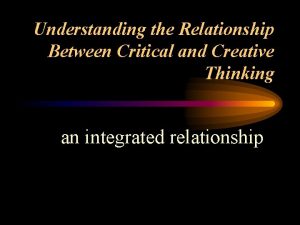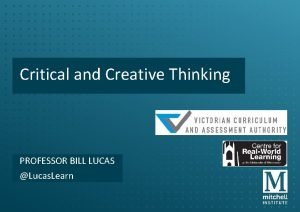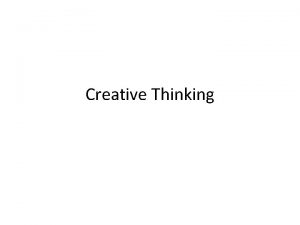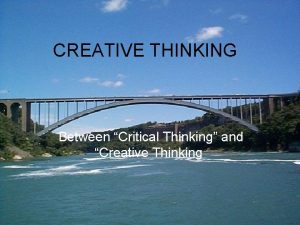Introducing Critical and Creative Thinking Victorian Curriculum F





- Slides: 5

Introducing Critical and Creative Thinking

Victorian Curriculum F– 10 • Released in September 2015 as a central component of the Education State • Provides a stable foundation for the development and implementation of whole-school teaching and learning programs • The Victorian Curriculum F– 10 incorporates the Australian Curriculum and reflects Victorian priorities and standards http: //victoriancurriculum. vcaa. vic. edu. au/

Aims Critical and creative thinking capability aims to ensure that students develop: • understanding of thinking processes and an ability to manage and apply these intentionally • skills and learning dispositions that support logical, strategic, flexible and adventurous thinking • confidence in evaluating thinking and thinking processes across a range of familiar and unfamiliar contexts.

Structure Strands Questions and Possibilities Reasoning Meta-Cognition Achievement standards • The first achievement standard at Foundation to Level 2 and then at Levels 4, 6, 8 and 10. • A curriculum for students with disabilities will be developed in this learning area.

Key messages • • Critical and creative thinking processes are fundamental to effective learning across the curriculum. This Victorian Curriculum F-10 design assumes that knowledge and skills are transferrable across the curriculum and therefore are not duplicated. For example, where skills and knowledge such as asking questions, evaluating evidence and drawing conclusions are defined in Critical and Creative Thinking, these are not duplicated in other learning areas such as History or Health and Physical Education. Explicit attention to and application of thinking skills enables students to develop an increasingly sophisticated understanding of the processes they can employ whenever they encounter both the familiar and unfamiliar, to break ineffective habits and build on successful ones, building a capacity to manage their thinking. Thinking that is productive, purposeful and intentional is at the centre of effective learning and the creation of new knowledge, with the progressive development of knowledge about thinking and the practice of using thinking strategies fostering students’ motivation for, and management of, their own learning.








